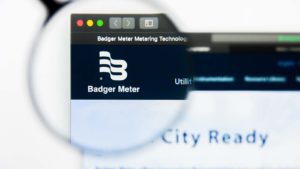Despite IoT being displaced as a vital tech innovation, the Global X Internet of Things ETF (NASDAQ:SNSR) has managed to hang on to $279 million of its net assets. Global X launched the ETF in September 2016, so it’s now in its eighth year as a publicly traded investment vehicle. That says something about its staying power.
SNSR tracks the performance of the Indxx Global Internet of Things Thematic Index, a collection of companies that stand to benefit from the broader adoption of IoT.
The cap-weighted ETF currently has 54 holdings. The top three industries by weight are semiconductors, telecommunications equipment and electrical products. I’ll try to choose one from each of these industries.
Here are my three IoT stocks to add to your February must-watch list.
Rambus (RMBS)
Rambus (NASDAQ:RMBS) is the 7th-largest holding in SNSR with a 3.56% weighting. Its stock has appreciated by 445% over the past five years, nearly 6x the S&P 500.
The San Jose-based semiconductor company was founded in 1990, went public in 1997, and today generates more than $461 million in annual revenue. It makes money in three ways: 1) sales of memory interface chips, 2) silicon IP licenses, and 3) patent licenses.
In 2023, its product revenue accounted for 49% of its revenue, while royalties from licensing accounted for the remaining 51%. Its gross margin in 2023 was nearly 78%, while its operating margin was 33.3%.
Unfortunately, its Q4 2023 results weren’t good enough for investors. Its shares lost 22% of their value on Feb. 6 and Feb. 7, erasing all their gains in 2024. That’s what happens when the analyst estimate is $0.45 a share, and you deliver eight cents less.
It finished 2023 with cash and marketable securities of $425.9 million. Based on its current and long-term operating lease liabilities of $30.7 million, it had net cash of $395.2 million, or $3.59 a share. It trades at less than 15x cash per share.
In terms of IoT, the company provides both Interface IP and Security IP solutions to leading chipmakers for their SoC (system on chip) and FPGA (Field Programmable Gate Array) designs.
Badger Meter (BMI)

Badger Meter (NYSE:BMI) is the 12th-largest holding in SNSR with a 2.46% weighting. Its stock has appreciated by 141% over the past five years, 1.7x the S&P 500.
The Wisconsin-based company manufactures smart-metering solutions that help water utilities, municipalities and commercial and industrial customers manage and measure water resources.
As far back as 2019, Badger focused on IoT and how it could help its clients’ water metering.
“Smarter solutions, powered by cellular and IoT-based technologies, are rapidly transforming the water metering industry and helping water utilities face the serious challenges ahead,” stated the company’s Key Water Utility Trends for 2020 report.
One example of the products it provides organizations interested in monitoring their water use is the Remote Monitoring (RM) ArcGIS Connector, which, combined with the company’s Telog family of IoT wireless data recorders, allows them to share data visualizations and analytics companywide.
Water is an expense that every organization must bear. The proactive use of these solutions enables them to reduce costs while being good community citizens.
Business was excellent in 2023.
Its revenues jumped 24% to $704 million, with operating earnings of $118 million, 35% higher than in 2022. Its free cash flow was $98.1 million, or 106% of its net income. A percentage above 100 is always good.
Charlie Munger loved companies that did good in their communities. Badger Meter does that many times over.
Samsara (IOT)

Samsara (NYSE:IOT) is the 14th-largest holding in SNSR with a 2.39% weighting. Its stock has appreciated by 45% over the past five years, nearly half the S&P 500.
How could I not choose Samsara, given its stock symbol?
Over the past year, it’s been the underperformer of this trio of IoT stocks. However, its shares have done much better over the past year, up more than 117%, nearly 6x better than the index.
Here’s what Samsara’s 2022 10-K says about IoT:
“Our Connected Operations Cloud consolidates data from our IoT devices and a growing ecosystem of connected assets and third-party systems, and makes it easy for organizations to access, analyze and act on data insights, using our cloud dashboard, custom alerts and reports, mobile apps and workflows,” states pg. 6 of its 10-K.
In the 10-K, the company highlights several use cases of its Connected Operations Cloud. I especially liked the one about a large city government reducing its fleet’s downtime by 28% by utilizing engine fault codes to provide more timely maintenance.
The best businesses make or save people or companies money and time. Samsara does both.
In its Q3 2024 results announced in late November, the company noted that 1,663 of its customers spent over $100,000 in annual recurring revenue (ARR), 49% higher than a year earlier.
On a GAAP basis, it had an operating loss of $200.3 million through the first nine months of fiscal 2024. However, it lost $12.2 million on a non-GAAP basis, down from $62.3 million a year earlier.
Most importantly, its ARR went over $1 billion for the first time in the third quarter. It reached this milestone in eight years.
On the date of publication, Will Ashworth did not have (either directly or indirectly) any positions in the securities mentioned in this article. The opinions expressed in this article are those of the writer, subject to the InvestorPlace.com Publishing Guidelines.
Will Ashworth has written about investments full-time since 2008. Publications where he’s appeared include InvestorPlace, The Motley Fool Canada, Investopedia, Kiplinger, and several others in both the U.S. and Canada. He particularly enjoys creating model portfolios that stand the test of time. He lives in Halifax, Nova Scotia.
